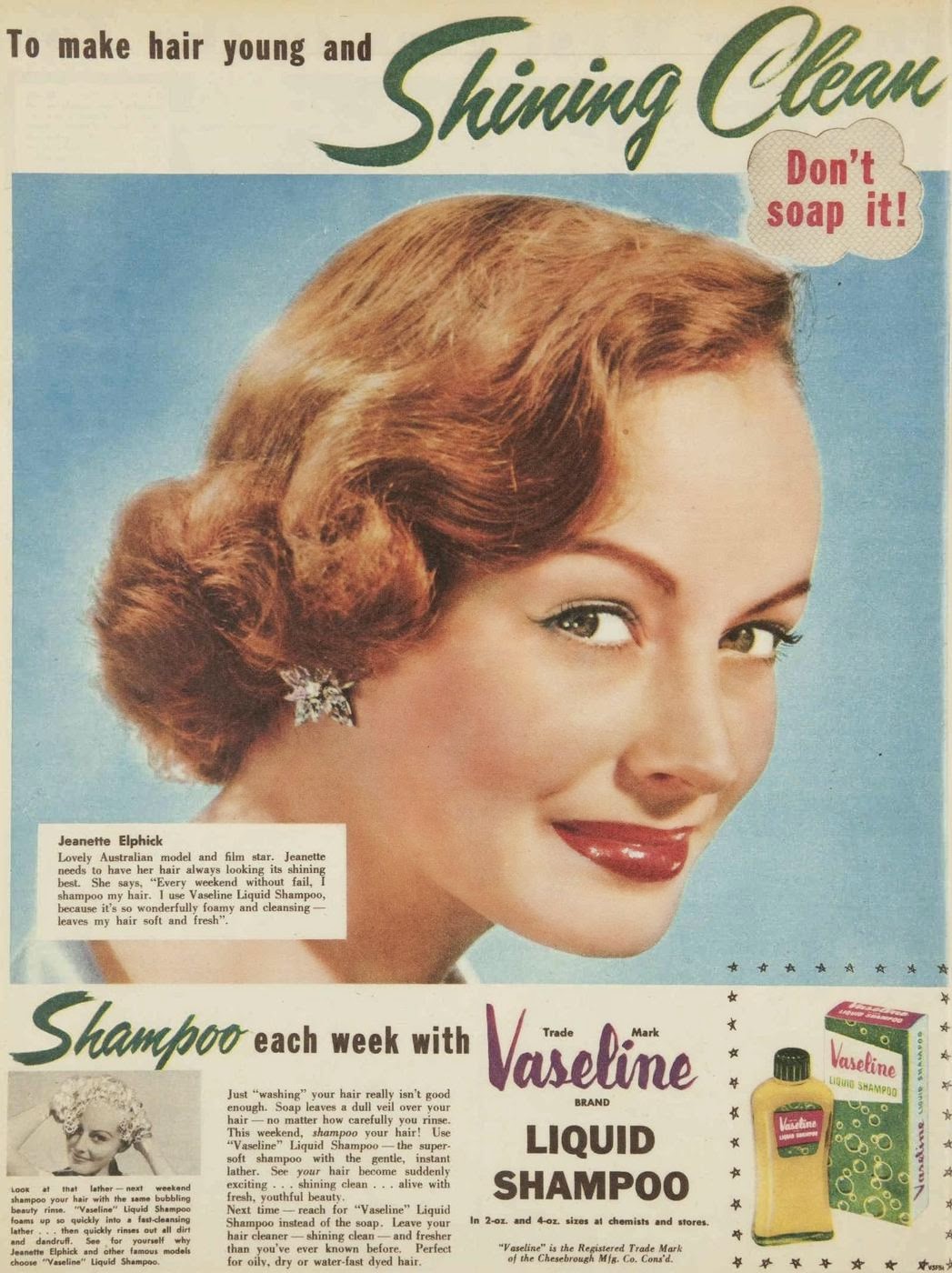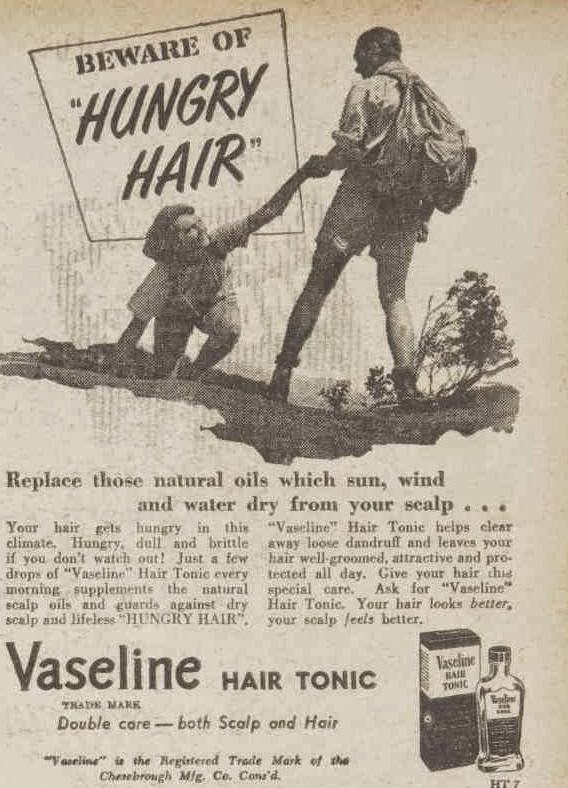I lovvve vintage, but unfortunately the 1950s were really the start of everything bad when it comes to cosmetics and beauty products. After World War 2 they seemed to be obsessed with cleanliness and banishing germs - and just as with housing there were so many new products and ingredients available - and you can see that by the ads of the time.
Hair had to be clean, neat and controlled.
Vaseline had been patented in the 1870s, and as a by product of petroleum production it was by no stretch of the imagination good for you, but the advertising of the 1950s put it and similar products at the forefront of consumers minds and made them appear safe, and necessary.
Petroleum is one ingredient that we shouldn't be using in cosmetics. According to world famous environmentalist and my all time hero, David Suzuki, there are twelve ingredients we need to avoid at all costs - he calls them the deadly 12 -
1. BHA and BHT
Used mainly in moisturizers and makeup as preservatives. Suspected endocrine disruptors and may cause cancer (BHA). Harmful to fish and other wildlife.
2. Coal tar dyes: p-phenylenediamine and colours listed as "CI" ,FD&C Blue No. 1" or "Blue 1
Potential to cause cancer and may be contaminated with heavy metals toxic to the brain.
3. DEA-related ingredients
In creamy and foaming products, such as moisturisers and shampoos. Can react to form nitrosamines, which may cause cancer. Harmful to fish and other wildlife.
4. Dibutyl phthalate
Used as a plasticizer in some nail care products. Suspected endocrine disrupter and reproductive toxicant. Harmful to fish and other wildlife.
5. Formaldehyde-releasing preservatives
Also in nail polishes
6. Parabens
Used in a variety of cosmetics as preservatives. Suspected endocrine disrupters and may interfere with male reproductive functions.
7. Parfum (a.k.a. fragrance)
Any mixture of fragrance ingredients used in a variety of cosmetics — even "unscented." Can trigger allergies and asthma, linked to cancer and neurotoxicity. Harmful to fish and other wildlife.
8. PEG compounds "eth" (e.g., polyethylene glycol).
Used in many cosmetic cream bases, if contaminated with 1,4-dioxane, may cause cancer. Also for related chemical propylene glycol and other ingredients with the letters
9. Petroleum
Used in some hair products for shine and as a moisture barrier in some lip balms, lip sticks and moisturisers, bay oil - makes an unbreathable barrier on the skin, ageing it faster and may cause cancer. Read more »
10. Siloxanes
Look for ingredients ending in "-siloxane" or "-methicone." Used in a variety of cosmetics to soften, smooth and moisten - also hair products. Suspected endocrine disrupter and reproductive toxicant
11. Sodium laureth sulfate - SLS
Used in foaming cosmetics, such as shampoos, cleansers and bubble bath, can be contaminated with 1,4-dioxane, which may cause cancer.
12. Triclosan
Used in antibacterial cosmetics, such as toothpastes, cleansers and antiperspirants. Suspected endocrine disrupter and may contribute to antibiotic resistance in bacteria. Harmful to fish and other wildlife
If, like my husband, you've gone - "What, but I remember my father using coal tar soaps for years", you can read more and download the fact sheet here. And there is also a downloadable pocket shopping guide, here. Products that have been advertised for over 100 years seem to be safe, don't they. Surely they wouldn't still be using products 100 years later is they were bad for you?
People have done stupid things for beauty (just think of arsenic in face powder to make skin white) and even sillier things to make money. Today there are many companies using the terms 'natural' and 'organic' when their products are anything but - you really need to read the labels and go with companies with a good reputation.
Stay tuned each Wednesday for some more vintage beauty ideas.
Deb
 |
| Nyal, 1955 |
 |
| Brylcreem 1955 |
And soap just wasn't good enough any more.
 |
| Vaseline shampoo, 1955 |
 |
| Vaseline hair tonic, 1950 |
1. BHA and BHT
Used mainly in moisturizers and makeup as preservatives. Suspected endocrine disruptors and may cause cancer (BHA). Harmful to fish and other wildlife.
2. Coal tar dyes: p-phenylenediamine and colours listed as "CI" ,FD&C Blue No. 1" or "Blue 1
Potential to cause cancer and may be contaminated with heavy metals toxic to the brain.
3. DEA-related ingredients
In creamy and foaming products, such as moisturisers and shampoos. Can react to form nitrosamines, which may cause cancer. Harmful to fish and other wildlife.
4. Dibutyl phthalate
Used as a plasticizer in some nail care products. Suspected endocrine disrupter and reproductive toxicant. Harmful to fish and other wildlife.
5. Formaldehyde-releasing preservatives
Also in nail polishes
6. Parabens
Used in a variety of cosmetics as preservatives. Suspected endocrine disrupters and may interfere with male reproductive functions.
7. Parfum (a.k.a. fragrance)
Any mixture of fragrance ingredients used in a variety of cosmetics — even "unscented." Can trigger allergies and asthma, linked to cancer and neurotoxicity. Harmful to fish and other wildlife.
8. PEG compounds "eth" (e.g., polyethylene glycol).
Used in many cosmetic cream bases, if contaminated with 1,4-dioxane, may cause cancer. Also for related chemical propylene glycol and other ingredients with the letters
9. Petroleum
Used in some hair products for shine and as a moisture barrier in some lip balms, lip sticks and moisturisers, bay oil - makes an unbreathable barrier on the skin, ageing it faster and may cause cancer. Read more »
10. Siloxanes
Look for ingredients ending in "-siloxane" or "-methicone." Used in a variety of cosmetics to soften, smooth and moisten - also hair products. Suspected endocrine disrupter and reproductive toxicant
11. Sodium laureth sulfate - SLS
Used in foaming cosmetics, such as shampoos, cleansers and bubble bath, can be contaminated with 1,4-dioxane, which may cause cancer.
12. Triclosan
Used in antibacterial cosmetics, such as toothpastes, cleansers and antiperspirants. Suspected endocrine disrupter and may contribute to antibiotic resistance in bacteria. Harmful to fish and other wildlife
If, like my husband, you've gone - "What, but I remember my father using coal tar soaps for years", you can read more and download the fact sheet here. And there is also a downloadable pocket shopping guide, here. Products that have been advertised for over 100 years seem to be safe, don't they. Surely they wouldn't still be using products 100 years later is they were bad for you?
 |
| Coal tar soap, 1952 |
People have done stupid things for beauty (just think of arsenic in face powder to make skin white) and even sillier things to make money. Today there are many companies using the terms 'natural' and 'organic' when their products are anything but - you really need to read the labels and go with companies with a good reputation.
Stay tuned each Wednesday for some more vintage beauty ideas.
Deb

No comments:
Post a Comment
Your comments are very important to me and I read each and every one of them! Please leave your blog address so I can visit.